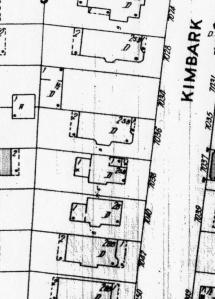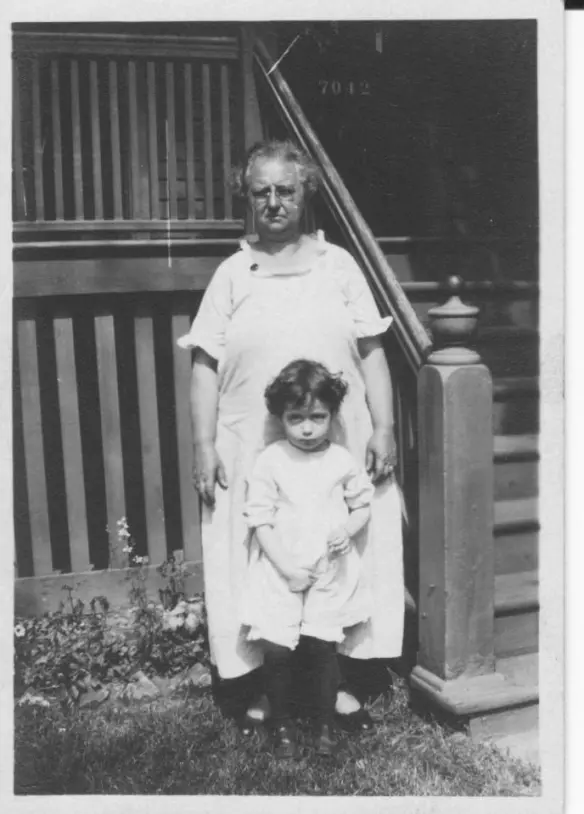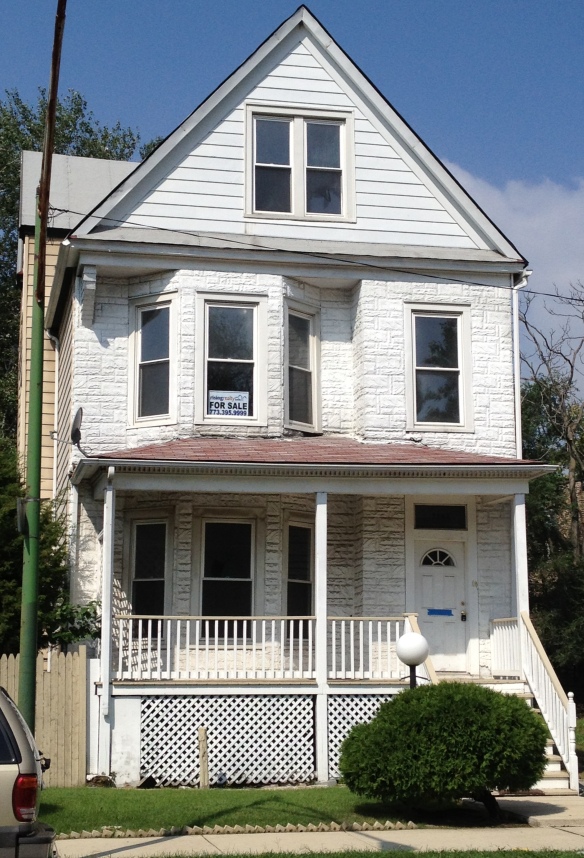I’ve written before on my family’s long-time home in Chicago, the “house on Kimbark.” On my recent research trip to the Windy City, one of my top priorities was to investigate when my great-grandfather actually bought the property, and if I was lucky, perhaps identify if my ancestors were among the first residents at the address. A trip to the Cook County Recorder of Deeds would hopefully shed some light on my questions.
Based on previous research and family tradition, I suspected Sophus Hansen (1860-1945) first moved to 7042 S. Kimbark in the mid-to-late 1890’s, soon after he married Rose Grobner (1878-1939). Sophus first appeared at the address in the 1899 Chicago city directory and remained there for nearly 50 years until his death in 1945.
In their outstanding property search database, the Cook County Assessor’s Office has recently estimated that the house is 112 years old, placing the construction date at c.1900. Here is a closeup image of the 7000 block of S. Kimbark Avenue from the 1895 Sanborn Fire Insurance Map for Chicago, clearly showing the footprint of the residence at 7042.

Sanborn Fire Insurance Map: Chicago, IL (Vol. 16: 1895), p. 87; 7042 S. Kimbark.
Located near the bottom of the image above, the residence is already there in 1895, tightly hemmed in on both sides. Since the house was built by the time Sophus was first listed there in the 1899 city directory, perhaps he was there before?
My visit to the Cook County Recorder of Deeds was particularly revealing. Armed with the exact legal description for the property (23.38.14, Lot 112, Brookhaven subdivision), I was thrilled with what I discovered in Tract Book #393:

Tract Book, Vol. 393, p. 149; Cook County (IL) Recorder of Deeds.
Two of the first entries for that property tie directly to Sophus Hansen. Dated 1887, this was quite a few years before I first estimated he was at the address, and in fact, only a month after his marriage to his first wife, Ursula.
Owning a property and having a house built there are two very different things entirely, so I maintained visions of grandeur that the Chicago building permits from the time period would reveal more about the construction date. However, as that collection only contains permits for structures built within the Chicago city limits, there was no record for the house’s initial construction. Indeed, at the time the Kimbark house was built, it was still part of Hyde Park, which was later annexed by Chicago in 1889, several years after my family home was already likely constructed.
I recently discovered this gem of an historic photograph, taken in c.1913. Although the trees obscure much of the house, one can still get a sense for the architecture, particularly the front porch. It is the only full-view historic image of the house that I’ve found.

7042 S. Kimbark Ave., Chicago (IL), c. 1913.
The older woman kneeling is likely Frederica Jarand Grobner (1854-1930) and the young woman on the right is likely Lydia Vierke Grobner (1886-1952); the young child is unidentified, although perhaps a child of Lydia’s.
Moving forward a few years, here is another image.

Rose Hansen & Shirley Russell, 7042 S. Kimbark, Chicago (IL), 1925.
Although no one is particularly happy about getting their picture taken here, I’m thrilled that it was, particularly given the visible “7042” on the front door. In this 1925 image, Rose Grobner Hansen is with her grand-daughter Shirley Russell (1922-2005).
By the time ownership of the home finally transferred outside the family in the late 1950’s, 4 generations of my pedigree had lived there, including my mother. This one residence, more than any other in my research, represents my family’s genealogical center, that one place that served as the family’s focal point through the generations. My grandmother would often charmingly share stories of family and friends with my brother and I, using the “house on Kimbark” as a reference point. With the family having left Chicago long before I was born, I was obviously at a loss for many of the tales, yet still tried to absorb as much as I could.
Here is a recent picture of the house, taken only a few weeks ago. The structure’s footprint still bears a remarkable similarity to the 1895 Sanborn Fire Insurance Map above.

7042 S. Kimbark, Chicago (IL), August 2012.
Note the sign in the 2nd story front window: “For Sale.” The genealogist in me would relish the opportunity to purchase the property and reclaim “the house on Kimbark” for the family. It would certainly make for a good story, wouldn’t it?
















